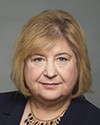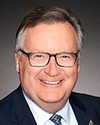Thank you.
First, I want to say thank you to the committee for giving me the time to present to you today in regard to the capacity of first nations in Canada, but more particularly in British Columbia. I'd also like to say thank you to the Algonquin people for allowing me to have such an audience with you today.
Having said that, I believe we submitted a presentation to you. Rather than go through the presentation myself directly....
I should apologize first of all to say that Christa Williams, who was at one point the executive director of the First Nations Public Service Secretariat, is unable to join us today for health reasons. In B.C. we have bronchitis, pneumonia and whatnot and it's sad to say she's one of the people who have been afflicted.
I thought I would give you a bit of background on who I am. My name is Howard Grant, and I'm the executive director of the First Nations Summit Society. I'm also a member of the chief and council of the Musqueam First Nation in British Columbia. I've been on council for 37 years. I'm an ex-bureaucrat. I worked for Indian and Northern Affairs from 1984 to 1993. I had the opportunity to work within the federal public service for a number of years. I'm also an ex-band manager. My whole life has been within the bureaucracy of government and first nations.
My traditional name is Qeyapalanewx VI. It was my great-great-great-grandfather who met Captain Vancouver in 1791 and Captain Narvaez in 1792. We have a long history in British Columbia, particularly our first nation, recognizing that we've had 300 years less contact with the European population and, therefore, having had the clear opportunity to maintain a lot of understanding of our complex governance system that was in place prior to the usurping of that with the European culture and the Indian Act. I was blessed and fortunate to have conversations with my grand-uncles who were 106 years of age in 1952, so 1848.... I'm talking about individuals who probably met the first Europeans. I'm only one example of a number of other people on the west coast to have such a luxurious background.
Having said all of that, I was a recipient of Indian Affairs program and service delivery as a young child, not knowing that government was there providing so-called resources. I also became a delivery agent as a band manager and also a policy-maker within the federal government in regard to how one would provide services to first nations.
In 1970, first nations started to take on program and service delivery, first of all, just handing out welfare cheques and whatnot rather than having to stand in line at a district or regional office. Then they allowed a salary level of approximately a CR-2 level. I don't know if you're familiar with government structure, but that CR-2 level was maintained throughout the 1970s and the 1980s, and from that period first nations and the federal government started to delegate more and more of their responsibility to first nations and their institutions, but again always looking at a CR-2 level, a very low clerical level position.
In the mid-1980s they decided they would give more responsibility to first nations to manage those programs, and asked for reports that looked at the management of those programs. Whether or not they utilized the information is not relevant at this point, but the significant point is asking them to manage something at a PM-5 and higher level, but still at a CR-2 wage scale. There was non-recognition of that balance.
In 1970 in British Columbia approximately 6,000 federal employees were delivering some kind of service to first nations. That also included teachers, etc.
Then the government, through Mazankowski, decided to downsize. With that came the fact that government downsized to where it is today with regard to about 300 people within the former department of Indian and northern affairs. There are about 8,000 first nation employees currently on staff at various first nations in British Columbia, but recognize that they are still at a CR-2 or CR-3 level salary base. Take those things into account, and recognize that those first nations people are still enjoying the luxury of having a minimal wage scale, if not less than that, but being asked to provide senior management with guidance, advice and reports. That's the backgrounder to what I have to say.
Then you also have a government policy that was established in the late 1960s and early 1970s. That policy states, “to provide...for status Indians living on reserve under the Indian Act...comparable to...Canadians...” in regard to services and programs; “to negotiate...forms of self-government...which increase Indian control and management...”; “to remove barriers and to facilitate Indian access to the economic expertise, capital and markets...” of the world; “to negotiate comprehensive claims...”; “to satisfy legal obligations...”; “to fulfill the terms of self-government legislation and associated formal undertakings....”
That is just a snapshot in regard to the policy of Indian and Northern Affairs Canada in the 1970s. We fast-forward to today and those policies now are what you call something new under the guidance of reconciliation, but they have always been there. The recognition of government as a whole—to recognize that they had that fiduciary—and a horizontal approach were non-existent up until most recent times.
Even today, that is still a fact. Most governments, most federal departments, acquiesce and say, “No. That's an ISC or a CIRNAC problem. Hand it over to them.” Yet there is the realization that the Prime Minister sent a mandate letter to every federal department, and those departments still today are not acknowledging that recognition and relationship that is required.
Having said all of that, we have to look at how to build capacity. We in British Columbia, under the First Nations Summit, created the First Nations Public Service Secretariat, recognizing that there was a need for something more. This secretariat was created a number of years ago under the regime of Gordon Campbell, former premier of British Columbia. We came to the federal government and asked for their support in regard to creating a two-pronged approach. The federal government said, “No. Sorry, but we're not into that.” That was 10 years ago.
We fast-forward to today. The federal government has come to a recognition and a realization to some degree that they need to re-aggregate, reposition, reconcile and work towards first nations self-determination, but under whose definition? Under whose definition do we define reconciliation?
True reconciliation requires the recognition of first nations governments under the Constitution, recognizing that there is a true nation-to-nation relationship that is required and, in order to have that relationship, to enhance the opportunity of first nations with their government structures. That's the requirement. So how do we build those kinds of relationships? It's through reconstituting, rebuilding or building a first nations public service, to regain a better understanding in regard to their complex governance system.
Indian and Northern Affairs from 1970 to today has tried to impose a European style of governance. They say that public admin is public admin. That is not necessarily so. We have to recognize that first nations are unique. Their circumstances are different. Carleton teaches federal public admin and the University of Victoria teaches provincial, but we have to deal with federal, provincial and municipal. On top of that, we don't have the institutions that all of your governments have in regard to supporting Crown agencies and business development.
We have a responsibility as a first nation to look at how we maintain our fiduciary, and at zero risk, so a first nations public service is a full requirement. I'll conclude by saying that we clearly recognize that four pillars are fully required. The first is senior management; the second is financial; the third is human resources; the fourth is in regard to records information management. Those are the clear four pillars that we've come to realize are full requirements.
With that, I want to conclude by saying that we have to ask tomorrow's questions today.
Thank you.




